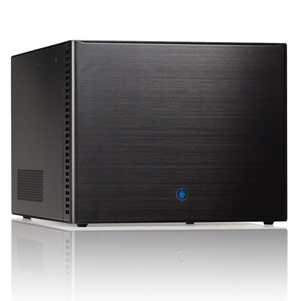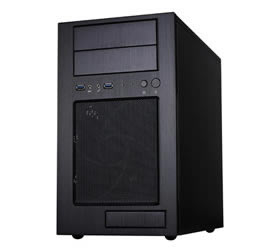File Server Builder's Guide
by Zach Throckmorton on September 4, 2011 3:30 PM ESTAs motherboard layout is important in ensuring that airflow is as unobstructed as possible, case design is also critical in facilitating excellent airflow. If you're building a system with one or two hard drives, most cases work fine for a home file server - just make sure there is a fan near the hard drive(s) so it is not sitting in stagnant air. However, if your server requires multiple disks, here are a few cases that work especially well for file servers.
Mini-ITX

Fractal's Array R2 is a nearly perfect home file server case. At less than 14" deep by 10" wide by 8" tall, it occupies little volume. It positions a removable hard drive cage immediately behind a quiet yet powerful 140mm intake fan. The hard drive cage accommodates up to six hard drives using vibration-dampening silicone mounts, and there is also room for a 2.5" drive (either an SSD or HDD). According to my testing, when stuffed with six low-rpm 2TB mass storage HDDs and one SSD (with an Intel Pentium G620 CPU installed), the temperatures of the HDDs hover around 40C even when all drives are under artificial sustained load (using Iometer). The PSU is a custom SFX form factor model, 80+ efficiency 300W unit with ample amps on the split 12V rail to power six HDDs. The PSU features seven SATA connectors and one legacy molex connector, so there are no extraneous molex plugs and enough SATA plugs. Furthermore, the cables are shorter than typical, so excessive cabling does not interfere with airflow. The case itself is constructed of aluminum so it is lightweight, and its overall build quality is very high. It does not have room for an optical drive, but I consider optical drives superfluous for a home file server. If necessary, you can always hook up a USB interface external optical drive. The only drawback of this case and its PSU is the price: at just under $200, it is not cheap. However, the subjective aesthetics, objective functionality of the case and the custom PSU are worth the cost if you want a small but capacious home file server case.
Micro-ATX

As I prefer home file servers that take up as little space as possible, Silverstone's TJ08B-E is a great, smaller micro-ATX minitower. It's less than 16" deep, 9" wide, 15" tall and weighs less than 12 pounds. It can accommodate up to five HDDs plus one SSD. As with the Fractal Array R2, the hard drives are placed immediately behind a front intake fan - though in this case, it's an even larger 180mm unit. The TJ08B-E is flexible in that it can hold a couple optical drives as well as a GPU in case you want to repurpose or multipurpose it. When stuffed with four low-rpm green drives, the temperatures under load don't exceed 45C during sustained transfers. Overall build quality is very good, like most Silverstone cases.
Silverstone makes a diminutive, fully modular PSU that makes working with smaller cases like the TJ08B-E, Lian Li PC-Q08, and others much easier. Silverstone also offers a short cable kit, making the ST50F-P PSU even better suited to SFF cases. Finally, it's clear that Silverstone had smaller multi-HDD systems in mind when designing the CP06 SATA power plug extension cable. This extender connects to a single SATA power plug and then has four SATA power plugs that are spaced closer than usual together, further reducing cable clutter. Though the cost of these accessories adds up, they make an ideal cabling solution very easy to implement. Regardless of whatever PSU you decide to go with, if you use a split 12V rail model, make sure you don't load up one rail with HDDs. If you go with a single 12V rail model, you'll want that rail to be beefy - for example, don't try to put ten HDDs and four case fans on a budget PSU with a 20A 12V rail.
Full Tower
Very few cases can accommodate ten HDDs at stock (without adding adapters), and such cases are not at all small. Full towers also typically offer excellent airflow, and cable management is not very difficult. Fractal's Define XL is one of the least expensive 10 HDD bay full tower cases available. It is well-built, and extra care has been paid to making the case quiet in the form of panel insulation. It is impossible to hear active HDDs inside this case even when you're sitting just a few feet from it (even the notoriously loud VelociRaptors). Further, there are plenty of integrated niceties like adjustable/flexible cable baffles that assist in cable management. Seven of the ten HDD slots are immediately behind fans, with three slots one cage removed from the front intake fans. Even still, the HDDs that aren't right behind the fans stay cool (between 35C and 40C). At around $150, it is an excellent value. Just make sure you don't pair it up with Silverstone's short cable kit!
We've saved the most important aspect of a home file server - the hard drives - for the next and last component page.











152 Comments
View All Comments
EnzoFX - Sunday, September 4, 2011 - link
What about something for a mostly Mac environment, and the occasional Windows system.DesktopMan - Sunday, September 4, 2011 - link
Anyone looking for a setup with many HDDs should take a look at port multipliers. You can get external cases for the HDDs, which saves your PC from a lot of heat. Connect using one ESATA cable per 5 drives and you don't need many ports either. (Just make sure they support port multipliers.)mongo lloyd - Sunday, September 4, 2011 - link
"It is impossible to hear active HDDs inside this case even when you're sitting just a few feet from it (even the notoriously loud VelociRaptors)."Maybe if you're half-deaf. And if you put 10 of them in that case, even your 97-year-old grandma would hear them.
Don't be fooled, a 5-10 disk cabinet will be rather loud and you probably don't want it near your person if you are sensitive to noise. No way around that.
Rick83 - Sunday, September 4, 2011 - link
Just skimming the CPU page, I see a problem: None of these CPU's accelerate encryption in hardware.Encrypting your hard-disks should be standard procedure, especially on a file server. You never know what someone may use against you, and in the case of a disk failure, you won't have to worry about sending in a disk with readable data on it.
Without hardware acceleration though gigabit ethernet may not end up being saturated, especially on the truly low end zacates and forget about atom...
My recommendation is the sandy bridge i5 2390T. Should be trivial to cool passively if there's enough fans to keep the chassis below 50°C.
Alternatively, there's VIA - but those nanos are somewhat harder to obtain in the retail channel (and even the 2390 is pretty hard to get)
And finally, something not touched on: first gen core i5 CPU's on old socket 1156 boards. As those go EOL good deals can be had, and there's no clear power savings advantage in sandy bridge.
RAM wise, 2GB is a huuuuge amount for a slim OS.
I'm running 2GB on my machine, and never hit swap -ever- and that's even though I am runnig gentoo and compiling my own kernels and running multiple other services besides samba and nfs.
Finally on boards: with a good deal you can get those SATA ports on the board on the cheap. Paid only 150 euro for my p55-ud5 last year, as it as going EOL. Bonus is you generally get a better featured board as well, so I also have IEEE 1394 and dual LAN.
DanNeely - Sunday, September 4, 2011 - link
Encryption is also one more factor to make things harder when everything goes wrong at once and you're trying to recover data. I'd rather write off the cost of the disks if they fail than impair my catastrophe recovery options.Rick83 - Monday, September 5, 2011 - link
That's why you have backups.DanNeely - Monday, September 5, 2011 - link
If your backup is still intact, not everything has gone wrong yet...Rick83 - Monday, September 5, 2011 - link
That's the point of the back up so, so that it's impossible for everything to go wrong.If everything goes wrong, there's usually a pretty big design flaw somewhere.
The impact of encryption is relatively negligible, excepting the performance impact.
don_k - Sunday, September 4, 2011 - link
That is why the article recommends a quality PSU. The enterprise space has 48 disk monstrosities, 10, even 20 drive home file server is perfectly possible - get a good PSU.chbarg - Sunday, September 4, 2011 - link
Excellent comment.Recently I built a W2008 server with an AMD processor without encryption support in hardware and I was surprised by the high CPU utilization by Truecrypt. In contrast, my laptop has an Intel CPU with encryption support in hardware and Truecrypt barely loads the CPU.
I use LUKS encryption in my file server at home for safety.
Regards,